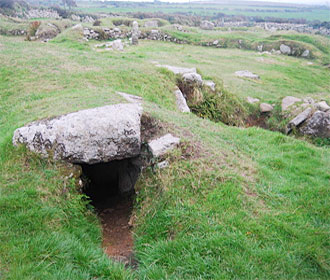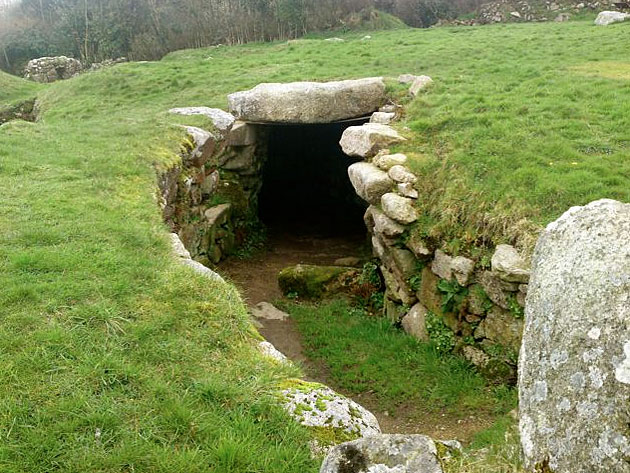Fogous
Fougous or fogous (pronounced foo-goos) are underground structures
that are historically made from dry stone. Much like the subterranean
houses that have been found in northern Europe and Scotland, they
consist of buried stone walls that taper toward the top and are
capped at the roof level using slabs of stone. They are commonly
found on Iron Age settlements in the area of Cornwall. Excavations
seem to suggest that fougous were purposely filled in when a settlement
was abandoned, but the reason for this is not known.
 Fogou
Fogou |
|
The word "fougou" comes from a Celtic word that means
"cave". The Cornish used to call them "fuggy holes,"
but the term has fallen out of usage in more recent years. To
build a fougou, a sloping trench was created and lined with stone.
They were then roofed using stone slabs, and the soil removed
in the excavation was piled on top. This created a dwelling that
was relatively sturdy and secure.
Fogou You …
There has been much speculation as to the possible uses of fougous.
All cultures within recorded time have built for multiple purposes.
It is doubtful that fougous were used as dwellings, since they
seem to be not as prevalent as other types of construction within
ancient communities. More likely they served a purpose for the
community as a whole, and the fougou would have been shared by
all the members of the community. Whether this purpose was practical,
protective or spiritual in nature is not known, although certainly
several theories abound.
Underground caves have been used by various cultures for different
purposes. Some souterrains have been found to contain stone balls
that present a mystery to archeologists and historians. Lacking
any apparent purpose, it is believed that they may have had some
sort of religious or ritual symbolism. Barns or byres have been
proposed as possible uses for other below-ground structures.

Carn Euny Fogou
Tacitus refers to the Germanic
tribes excavating caves and then covering them
with dung for use as storehouses and for protection against the
cold. No one really knows what a fougou was used for, but many
have speculated that they may have been used as refuges from invading
hordes, for use in religious activities or rituals or to store
food. Obviously they were important to the community, since they
were centrally located.
Halliggye Fougou located on the Trelowarren estate is generally
considered to be the best and largest surviving fougou. It is
open to the public between April and October. There are also unspoiled
fougous at Boleigh near Lamorna, Trewardreva near Constantine
(locally referred to as Pixie's Hall), Carn Euny (pictured above)
and Pendeen.
Partially intact fougoos are found at Boden Vean near Manaccan,
Lower Boscaswell near Pendeen, and Chysauster.
Evidence of what may or may not be fougous is present at Castallack,
Treveneague, High Bodinar and Porthmeor. There was further evidence
found at Penhale Round, but it has been destroyed. One of the
most northerly fougou sites is located in Scotland's Orkney Islands,
at Castle Bloody, which is located on Shapinsay Island.
|

